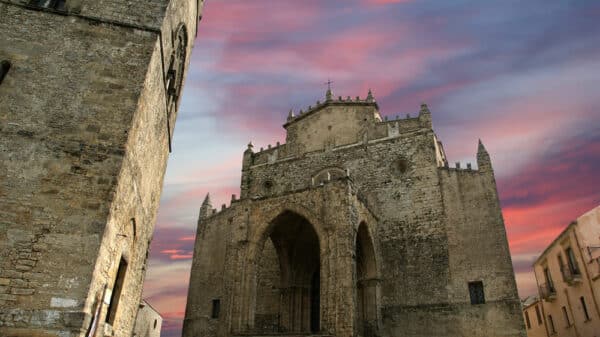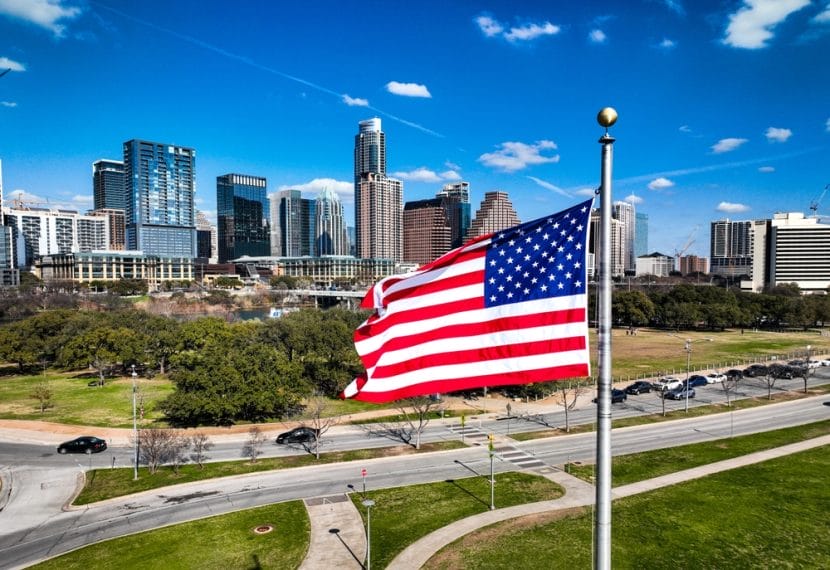Alabama
The history of Alabama’s flag harbors stories of remarkable locals like Helen Keller and Rosa Parks, who were nurtured under its emblem. Alabama adopted its own banner on February 16, 1895, 76 years after joining the Union. Their choice was a “crimson cross of St. Andrew on a field of white,” reminiscent of the Confederate flag. The flag aimed to preserve distinctive features of the Confederate battle flag, as stated by the Alabama Department of Archives and History.
An interesting fact is that Alabama’s flag is among the few state banners that exclude the color blue. The other states on this short list are California, Maryland, and New Mexico.
Alaska
Alaska, the largest state in the union, often surprises non-Alaskan Americans with its vast expanse, twice the size of Texas and approximately one-fifth of the entire U.S.A. In 1926, Alaska held a flag-designing contest for children, won by 13-year-old John “Benny” Benson. His design, featuring the Big Dipper constellation and the North Star on a field of blue, pays homage to the Alaskan sky and the Forget-me-Not flower.
For his design, Benson explained, “The North Star is for the future of the state of Alaska, the most northerly in the Union. The Dipper is for the Great Bear—symbolizing strength.” His achievement was rewarded with US$1,000 and an engraved watch.
Did you know that the current flag of the U.S.A with 50 stars and 13 stripes was also crafted by a teenager? In 1958, 17-year-old Robert G. Heft of Lancaster, Ohio, won a competition with his flag design selected by President Dwight D. Eisenhower out of 1,500 entries!
Arizona
Arizonans take great pride in their state flag, and in 2001, it ranked sixth among 72 North American flags in a poll conducted by the North American Vexillological Association, marking it one of the “10 best flags on the continent.”
The Arizona state flag, adopted in 1917, consists of two distinct halves. The top part features 13 alternating red and yellow rays representing the original 13 colonies, a nod to the Spanish flags carried by Francisco Vázquez de Coronado, while also depicting the state’s picturesque horizon.
The bottom half is solid blue, paying tribute to the U.S.A. flag, with a large copper-hued star symbolizing Arizona’s status as the nation’s top producer. A truly captivating flag!
Arkansas
A lesser-known fact is that mispronouncing “Arkansas” while in the state is against the law, owing to its French origins. The simplicity of Arkansas’ flag may not appeal to many, but it holds rich symbolism. The large diamond symbolizes its status as the only diamond-bearing state during its design, while the 25 stars around the diamond signify Arkansas as the 25th state admitted to the Union.
The three blue stars below the state’s name carry a dual significance, representing the three countries Arkansas has been a part of: Spain, France, and the United States, as well as highlighting its Louisiana Purchase history. Notably, the lone star added in 1923 stands for the Confederacy, with the border around the white diamond reminiscent of the saltire on the Confederate battle flag.
California
California, the most populous state in the USA with 39.56 million residents, shelters three of the country’s ten largest cities: Los Angeles, San Diego, and San Jose.
The flag of California was officially adopted in 1911, stemming from an act of rebellion against Mexico in 1846. The California grizzly bear on the flag, once abundant in the state, symbolizes strength and was meant to intimidate Mexican authorities. The red star pays homage to the “lone star of Texas.”
Despite its historical significance, some Californians advocate for a new state flag as the bear image no longer represents the state’s essence. Do you think any U.S. flags are in need of a redesign?
Colorado
Coloradans likely know that the state’s name in Spanish translates to ‘red-colored’, reflecting its reddish earth.
Colorado’s flag, adopted in 1911, draws inspiration from its scenic landscapes. The blue symbolizes the state’s clear blue skies, while the white stripe represents its snow-capped Rocky Mountains.
The red “C” at the flag’s center mirrors the red in the U.S. flag, representing Colorado’s crimson earth, with a golden disk inside the “C” celebrating the state’s abundant sunshine.
Connecticut
Connecticut, known as “the Constitution State,” was named after the Fundamental Orders established in 1639, considered North America’s first written constitution.
The Connecticut state flag was officially adopted in 1895, featuring a blue flag with a white shield bearing three grapevines representing religion, liberty, and knowledge. The three original colonies— Saybrook, New Haven, and Connecticut (Hartford)—that merged to form one state are also symbolized.
Below the shield, a Latin banner inspired by Colonel George Fenwick’s official seal purchased from England depicts the motto “Qui Transtulit Sustinet,” meaning “He Who Transplanted Still Sustains”.
Delaware
Delawareans may be surprised to learn that reggae pioneer Bob Marley once resided in Delaware. He lived inFrom 1965-1977, the state was governed by its governor, and during that time his son, Stephen Marley, was born in Wilmington.
Delaware, also known as the “First State,” was the initial state to ratify the federal Constitution on December 7, 1787, hence becoming the pioneering state admitted to the union. The colors on the state flag, buff, and colonial blue, symbolize those of a uniform worn by General George Washington.
Florida, also recognized as “the Sunshine State,” brags about having the second-most extended coastline in the nation. Its flag showcases a crimson St. Andrew’s cross bearing the state seal in the middle, depicting a shoreline and a Seminole woman distributing flowers.
Georgia, notable for the Cyclorama Building in Atlanta, changed its state flag three times since 2001. The present flag was selected post a statewide vote in 2004 and is influenced by the “stars and bars” of the Confederate flag without the inclusion of the St. Andrew’s cross.
Hawaii’s state flag, established in 1845, encompasses the red, white, and blue stripes of the U.S. flag and the British Union Jack of the U.K. The eight stripes signify the eight primary islands in the chain.
Idaho is identified as “the Gem State”. Its flag, akin to the U.S. flag in navy blue, features the state seal crafted by Emma Edwards, mirroring Idaho’s principal sectors of mining, agriculture, forestry, and wildlife.
The state flag of Illinois exhibits a bald eagle clutching a red banner in its beak with the state’s motto, “State Sovereignty, National Union.” The word “sovereignty” is positioned upside down to enhance reading difficulty.
Indiana’s flag in deep blue portrays a torch in the center symbolizing liberty and enlightenment. It includes a sum of nineteen stars representing the originating thirteen colonies and the subsequent five states anticipated to unite the Union.
Iowa’s flag, sanctioned in 1921, displays vertical red, white, and blue colors symbolizing the flag of France and representing the Native Americans residing there before the European colonization.
The flag of Kansas, put in place in 1927, comprises a dark-blue backdrop with the state seal at the core and a native sunflower, the state flower. A gold and blue bar amidst the sunflower and the seal symbolizes the Louisiana Purchase. The seal reveals the state motto, “Ad Astra per Aspera,” which translates to “To the Stars through Difficulties,” coupled with thirty-four stars denoting that Kansas was the 34th state to enter the Union. The word “Kansas” was appended at the base of the flag in 1961.
Kentucky’s state flag highlights the Bluegrass State’s seal placed in the heart of a navy blue background. The seal exhibits two individuals, one sporting buckskin representing frontiersmen, and the other in a suit denoting statesmen. It likewise encompasses the state motto, “United We Stand, Divided We Fall,” alongside a goldenrod wreath. It is speculated that the buckskin-clad figure might be Daniel Boone, and the gentleman in the suit could be Henry Clay.
The state flag of Louisiana is a vivid azure blue showcasing a “pelican in her piety,” symbolizing the state’s self-sacrificing nature towards its citizens. The flag also features the state motto, “Union Justice Confidence.”
Maine’s prevalent state flag presents the Maine Coat of Arms on a blue field illustrating a farmer with a scythe, a seaman with an anchor, and a moose lounging under a substantial pine tree. The state’s motto, “Dirigo” meaning “I lead,” is inscribed amidst the shield and the North Star.Three sets of plows and a sash show the motto of the state “Liberty and Prosperity” and “1776”, which is the year that New Jersey became a state.
In 1920, New Mexico introduced its state flag, which highlights the Zia sun icon symbolizing the Circle of Life. This emblem showcases four sets of rays extending out from the sun in four directions at right angles. The flag’s vibrant red Zia sun is positioned in the middle of a bright yellow background, paying homage to the Spanish explorers who arrived in Mexico during the 1500s. to the four winds, four seasons, four directions, and four sacred duties.
New York’s state flag includes the state seal set against a blue backdrop, with two goddesses, Liberty and Justice, positioned on each side to symbolize “Liberty and Justice for all”. The seal additionally features an American eagle gazing westward, perched atop a globe, and a ribbon displaying the state motto, “Excelsior”, which translates to “Ever Upward” in Latin. On the shield, you can see two ships navigating the Hudson River, with three mountains in the background and a rising sun.
North Carolina’s state flag features the colors red, white, and blue, with a golden sash above the state initials “N” “C”, separated by a white star and showcasing the date “May 20, 1775.” This date commemorates the “Mecklenburg Declaration of Independence.” Below, another ribbon displays the date “April 12, 1776”, referring to the “Halifax Resolves,” which relates to North Carolina’s delegates voting for independence during the Continental Congress.
During the Civil War, the “The Old North State” Infantry carried both a regimental and Confederate flag. The design from 1885 remains unaltered to this day.
The flag of North Dakota portrays a traditional bald eagle clutching an olive branch and a bundle of arrows, symbolizing “peace through strength.” The eagle’s chest features a shield in red, white, and blue with 13 stripes, while above the eagle, there are 13 stars, representing the original 13 states. Below the eagle, the state name “North Dakota” stands out on a red ribbon.
Ohio’s state flag, adopted in 1902, takes on a burgee shape and showcases alternating red and white stripes. The 13 stars to the left represent the original 13 states, with an additional four stars to the right symbolizing Ohio as the 17th state to join the Union.
Inspired by the original Native American inhabitants, Oklahoma’s state flag features an Osage warrior’s buffalo-hide shield adorned with seven eagle feathers. The flag also depicts an olive branch crossed with a peace pipe, symbolizing harmony between Europeans and Native Americans.
In the state of Oregon, the flag proudly displays a different design on each side, both navy blue with a golden motif. One side exhibits the state seal while the reverse side features a beaver, the state’s official animal, symbolizing Oregon’s historical significance in beaver trapping and trading.
Pennsylvania’s state flag, authorized back in 1799, showcases the State Coat of Arms on a deep “Old Glory” blue field, with two black horses supporting the shield.
Established in 1897, Rhode Island’s state flag features a golden anchor encircled by 13 gold stars on a white canvas. The anchor carries the state motto “Hope” in gold and sits on a blue ribbon.
South Carolina’s state flag includes a central palmetto tree, symbolizing the valiant defense of the palmetto-log fort on Sullivan’s Island against the British naval forces. The flag also portrays a crescent moon and a navy blue field symbolizing the attire worn by South Carolina’s fighters during the conflict.
The flag of South Dakota showcases a seal at the heart of a sky-blue background, portraying a picturesque scene of a steamboat on a river, a farmer tilling the land, and mountains in the backdrop. Additionally, the flag bears the state motto “Under God the People Rule” and the phrase “South Dakota, The Mount Rushmore State.”
Tennessee’s flag features an emblem with three stars on a blue circle set against a vibrant red canvas, with a dark blue stripe located on the fly side. These three stars symbolize purity, united by the infinite loop of the blue circle representing an unbreakable trinity.
Known for its iconic lone star design, Texas’ official state flag is renowned as one of the most recognizable flags in the United States. According to Texas Hill Country, this star is a representation of Texan unity following their declaration of independence from Mexico. Moreover, the blue stripe signifies loyalty, white denotes purity, and red represents valor, embodying both Texan and American ideals. Adina de Zavala, an author, once stated that each point embodies the traits of a stellar citizen, including courage, fidelity, righteousness, prudence, and open-mindedness.
Utah’s state flag encompasses the state seal, instated in 1896, encased within a golden ring located at the center of a deep blue backdrop. Known as “The Beehive State,” Utah prominently features a beehive on its state flag, symbolizing diligence and industry. The beehive is flanked by sego lilies, the state flower, which also represents peace. The state motto “Industry” adorns the top, with “Utah” displayed beneath it on a crimson banner. Above the seal, an eagle poised for flight overlooks six arrows below, with two American flags on either side of the coat of arms. The flag also bears two significant dates: 1847, the year Brigham Young and the Mormon settlers arrived in Salt Lake Valley, and 1896, when Utah officially became the 45th state of the Union. Although the design of the Utah state flag has remained largely untouched since 1913, there are ongoing debates among Utah legislators regarding the adoption of a new state flag.
Vermont, renowned for its high-quality dairy products, proudly showcases a red heifer on its flag. Additionally, the state’s coat of arms includes a vast pine tree and three sheaves of wheat, with towering mountains in the distance, symbolizing the state’s breathtaking landscapes and flourishing agriculture. At the top of the coat of arms rests a buck’s head. Two crossed pine boughs flank the sides, positioned under a ruby banner bearing the inscriptions “Vermont” and the state motto, “Freedom and Unity”, positioned below.
Interestingly, Virginia’s state flag was officially adopted as the state seceded from the Union in 1861, on the eve of the Civil War. The bright azure flag highlights Virginia’s seal, featuring Virtus, the Roman goddess of virtue, brandishing a downward-pointing spear and an upward-facing sword. Virtus is depicted standing on Tyranny, a fallen crown at his side symbolizing Virginia’s emancipation from British monarchical oppression. At the top, “Virginia” is emblazoned, followed by the state motto: “Sic Semper Tyrannis,” translating to “Thus Always To Tyrants”. A pretty intense emblem, we must say.
A common misconception holds that Seattle is Washington’s capital city when in reality, it’s Olympia! This confusion is understandable as Seattle stands as the most popular and populous city in the state, with nearly 60 percent of residents residing in the Seattle metropolitan region. Contrasting the preceding blue backgrounds, Washington’s state flag brings a refreshing change with its green hue! At the core lies the state’s seal, featuring President George Washington. The State Seal depicts a bust of the first U.S. president against an “oriental blue” background, encircled by the phrase “The Seal of the State of Washington” on a golden shade backdrop, with “1889” inscribed at the bottom to mark the year Washington obtained statehood. The state seal’s presence on both sides renders this flag one of the most expensive to produce. Additionally, the Washington State Flag stands out as the sole flag featuring a green field and an individual, even more unique that being an American president. A truly iconic emblem indeed.ready.
June 20, 1863 saw the separation of West Virginia from Virginia, making it an autonomous state in the Union. Not long after, the state legislature sanctioned an official State Seal, which forms the main element of the West Virginia Coat of Arms and later emerged as the primary feature of the state flag.
The State Seal depicts a large rock with two individuals by its side – one a cultivator and the other a miner, symbolizing the key sectors of agriculture and mining in the state. Etched on the rock is the significant date “June 20, 1863”. Directly in front of these figures and the boulder sit a pair of crossed rifles, topped by a red liberty cap, a representation of liberation.
Beneath lies a red ribbon bearing the state motto: “Montani Semper Liberi,” translating to “Mountaineers are always free” in Latin. Hovering above the seal is another red ribbon carrying the words “State of West Virginia” encircled by a wreath of “great laurel,” the state flower. A truly striking flag!
If you have a penchant for gelato, you share a commonality with the Wisconsinites, who collectively consumed close to 21 million gallons. Despite their fondness for the chilly delicacy, it didn’t make the cut for the state flag. Instead, the flag showcases the state coat of arms which brims with symbolism.
At the top, the flag design flaunts the state motto “Forward”, just below it sits the state animal, the badger. Positioned at the heart of the blue backdrop is the state seal, flanked by a sailor and a miner, emblematic of the hardworking denizens of the state who toil on land and sea.
Within the shield are four quadrants each symbolizing the primary industries of the state: Navigation (anchor), Mining (pick and shovel), Agriculture (plough), and Manufacturing (arm and hammer). The cornucopia and lead beneath the seal are reflective of the state’s agricultural bounty and mineral wealth.
In 1979, the flag underwent an amendment to incorporate the state’s name “Wisconsin” and the statehood date “1848”, marking its accession as the 30th state in the Union.
Wyoming might not be your go-to for “island vibes,” but did you know there are 32 named islands within its borders?!
The design of the Wyoming State Flag was crafted by Verna Keays, a 24-year-old contest participant in 1916. Encased within a navy blue canvas accented with a red (outer) and white (inner) border, symbolizing the pioneers’ blood and purity, stands a silhouette of an American bison. Imprinted on its flank is the state seal of Wyoming.
The seal portrays a veiled figure, likely lady Liberty, wielding a staff adorned with a banner inscribed “Equal Rights.” It is apt as Wyoming spearheaded granting women the right to vote first among all U.S. territories. Flanking the lady are two male figures representing the livestock and mining sectors.



































